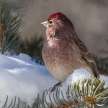
The red-winged tinamou (Rhynchotus rufescens) is a medium-sized, land-living bird from central and eastern South America. Some specific names for the genus include perdiz grande, ynambu and rufous tinamou. Both tinamou are from the family Tinamidae, and are thus ratites in the broader scheme. Unlike other ratites, tinamous can float but in general they are not good fliers. All ratites evolved from ancient flying birds, and tinamous are the closest surviving descendants of such birds. Coenraad Jacob Temminck first described the red-winged tinamou from a specimen from São Paulo state, Brazil, in 1815. The red-winged tinamou has three subspecies: Rufescens, the called race, occurs in south-eastern Peru, Bolivia, southeastern Paraguay and northeastern Argentina, and possibly Uruguay; Catingae occurs in central and north-eastern Brazil; Pallescens occurs in northern Argentina; east Formosa, Chaco, Santa Fé, Córdoba, La Pampa, Buenos Aires, Entre Ríos, Corrientes, and Rio Negro. The taxon maculicollis was initially considered a red-winged subspecies of tinamou, but it is now considered, after SACC, to be a species in its own right; the huayco tinamou. The common name refers to the bright rufous primaries which are often visible during flight. The red-winged tinamou is about 40 to 41 cm long and weighs about 830 g, and the female can be much larger. This has a black crown, rufous primary beneath, and light-gray to brown. It may have black bars on flanks, belly and airflow. The throat is also whitish, with cinnamon in the foreneck and the breast. The pointed bill is horn-coloured, with a blackish culmen. This covers Southeastern, Northeastern, and Southern Brazil, East Paraguay, Southeast Peru, Bolivia, and Eastern Argentina. At lower elevations this avoids marshy grasslands and edges of forest. While at higher elevations of up to 2,500 m it may visit arid shrubland, pastures, and grain fields. Generally this supports dry savanna. The red-winged tinamou has vocal males followed by shorter sad whistles, which are a continuous ringing single whistle. The woman hits not. This species is most involved during the heatiest hours of the day. The diet varies by season; it takes insects and other small objects during the summer, and it turns to vegetable matter such as berries, shoots, tubers and bulbs during the winter. It can be an agricultural pest, feeding on cereals, rice and peanuts, as well as predatory, capturing poisonous snakes and occasionally flying up into the air to capture an insect from a vineyard. The species ' male targets the female by feeding and then heading to the nest where she lays her eggs and then the chicks are born. As all tinamous, the red-winged tinamou is a common hunting destination and has declined in areas with high population density, but the species has also expanded in some areas where forest clearance has created suitable habitat. Generally it is not considered a threat, and is thus listed as the Least Concern by IUCN. It has a gross surface area of 5,700,000 km2. Red-winged Tinamou is a stocky tinamou in the east of the Andes, in central South America, with marshes, grasslands and agricultural areas. It's round-bodied, with black barring on slender brown wings and tail, a ruddy-colored head, dark crown and a thick, slightly decurved bill. There are three known subspecies: Peru, Bolivia, Paraguay, southeastern Brazil, and northern Argentina nominate rufescens; central and northeastern Brazil catingae; and central and northern Argentina pallescens. While poaching pressure and habitat destruction due to burning have resulted in destruction of population, Red-winged Tinamou still usually abounds across its large geographic range. Red-winged tinamou takes longer time than other birds to reach mature weight, and steps should be taken to shorten this time period for commercial production.
About the Creator
MB
I am a bird aficionado and really enjoy spotting them them on hikes. I greatly appreciate the variety of birds cross North America and the world. They are amazing and intelligent creatures, each so unique and with a wonderful life.






Comments
There are no comments for this story
Be the first to respond and start the conversation.